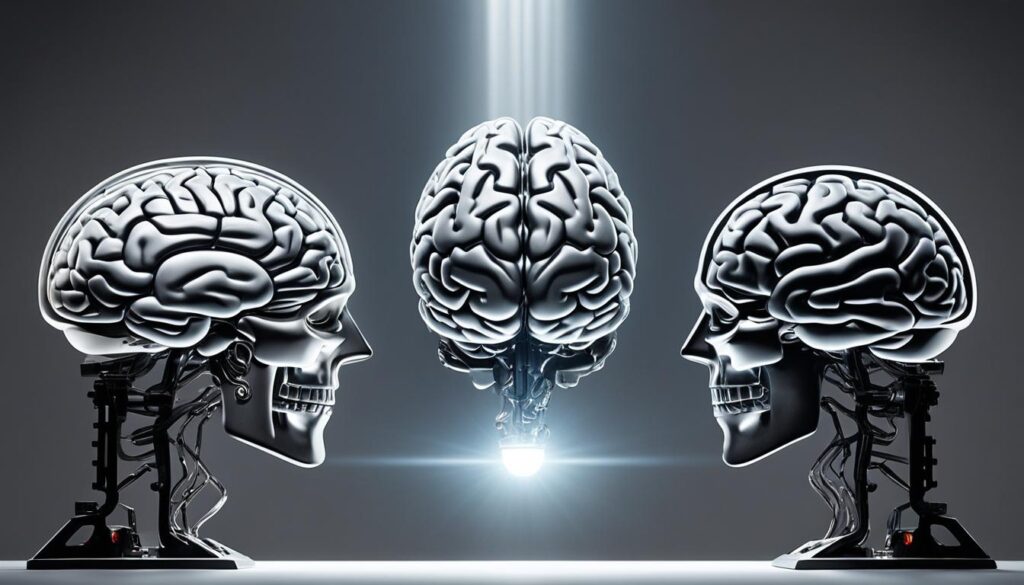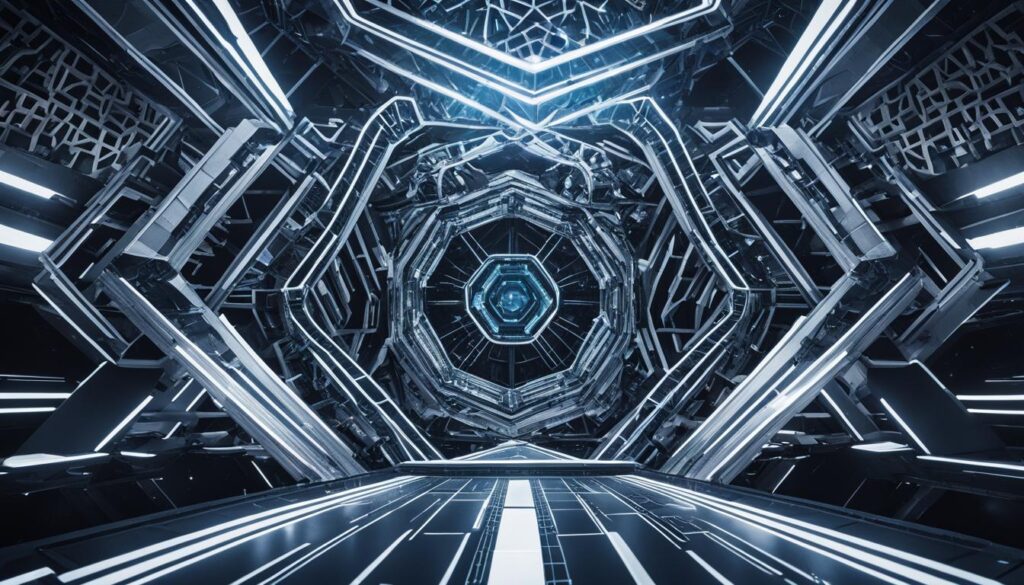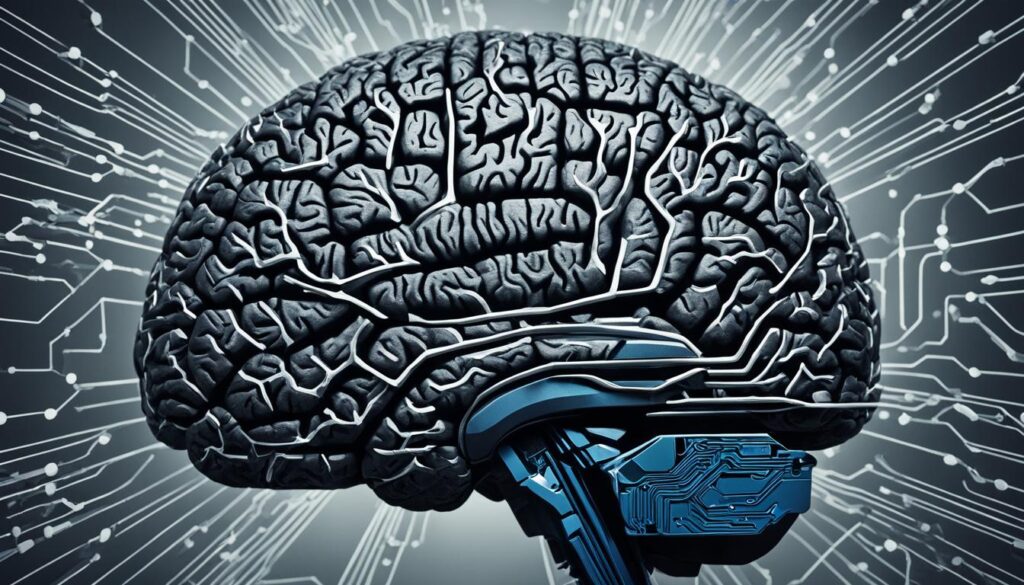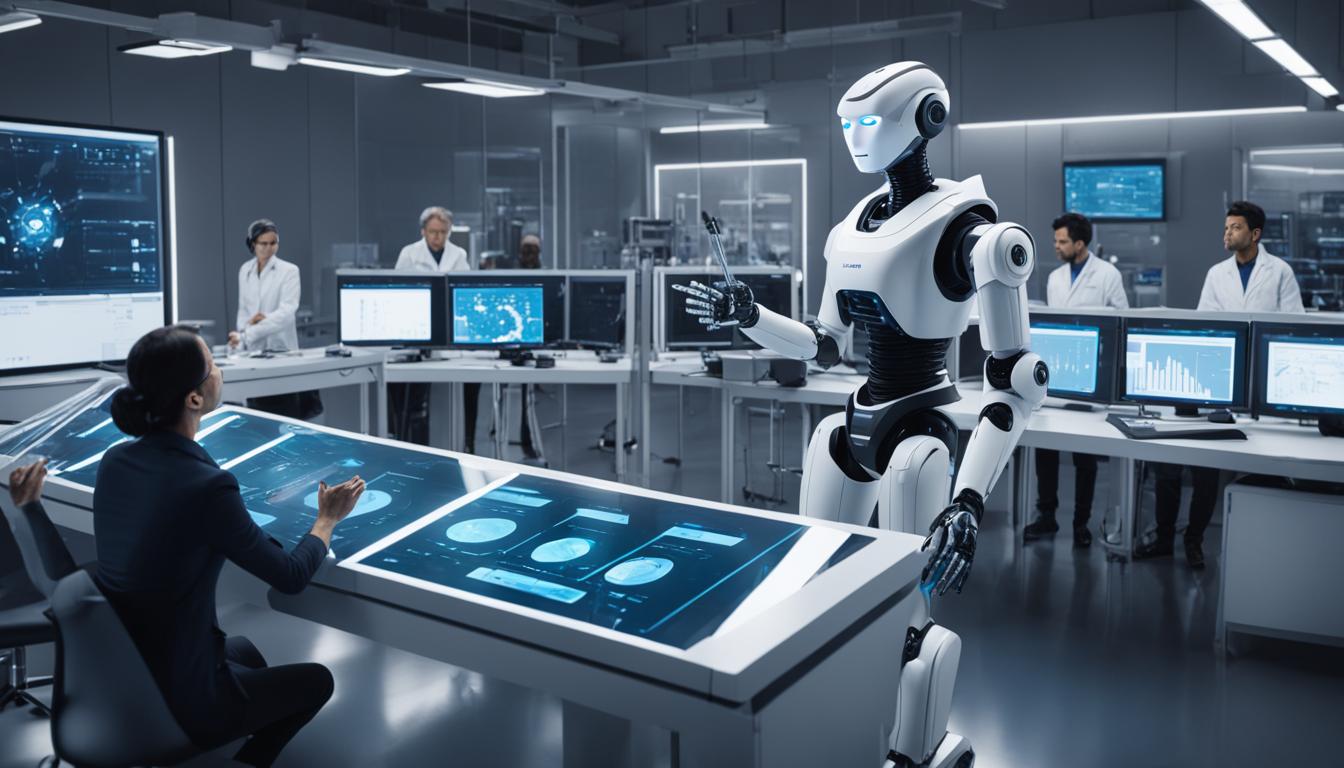Artificial intelligence (AI) has been a topic of fascination and speculation for years. Can it truly surpass human intelligence? Is it capable of outsmarting us in every aspect? Let’s delve into the capabilities of AI and human intelligence to uncover the truth.
Some experts, like futurist Ian Pearson, believe that AI has the potential to be “billions of times smarter” than humans. They suggest that to keep up with AI’s advancements, we may need to merge with computers and establish a direct link with the human brain. This idea aligns with the perspective of tech visionary Elon Musk, who advocates for the integration of humans and machines to stay relevant in the face of AI’s progress. However, it’s crucial to note that there are varying opinions on this topic.
While AI excels in certain areas, such as pattern recognition and logical reasoning, it is important to recognize the unique capabilities of human intelligence. Humans possess the ability to comprehend complex emotions, think abstractly, and consider different perspectives – qualities that AI currently lacks. While AI may outperform humans in convergent thinking (finding one solution to a problem), humans possess the power of divergent thinking, allowing for creativity and thinking outside the box.
Contents
- 1 AI’s Convergent vs. Divergent Thinking
- 2 The Differences in Human and Machine Intelligence
- 3 AI’s Potential in Making Better Decisions
- 4 The Role of Machine Learning in Everyday AI
- 5 The Ongoing Debate: Is AI Smarter Than Humans?
- 6 Conclusion
- 7 FAQ
- 7.1 Can artificial intelligence be smarter than humans?
- 7.2 Is AI capable of outsmarting humans?
- 7.3 What are the differences between machine intelligence and human intelligence?
- 7.4 Can AI make better decisions than humans?
- 7.5 What is the role of machine learning in everyday AI?
- 7.6 Does AI have creative potential?
- 7.7 Is AI smarter than humans?
- 7.8 What is the future of AI and human intelligence?
- 8 Source Links
Key Takeaways:
- Artificial intelligence has the potential to surpass human intelligence but currently lacks key human qualities.
- AI excels in tasks that require pattern recognition and logical reasoning.
- Human intelligence encompasses emotional comprehension, abstract thinking, and creativity.
- Both AI and human intelligence have strengths and limitations that need to be considered.
- The integration of human and AI intelligence can lead to better problem-solving and advancements in society.
AI’s Convergent vs. Divergent Thinking
When it comes to problem-solving, AI and humans approach it from different angles. Convergent thinking, which involves finding a single solution to a problem, is an area where AI surpasses human intelligence. Machines have the ability to analyze vast amounts of data quickly and accurately, making them highly efficient at tasks that require pattern recognition and logical reasoning. This proficiency in convergent thinking has enabled AI to excel in various fields, from data analysis to complex calculations.
On the other hand, humans possess a unique type of thinking called divergent thinking. This involves generating multiple solutions to a problem and thinking outside the box. Humans can bring creativity and consider different perspectives when faced with challenges. Divergent thinking allows for innovation, exploration, and the discovery of new possibilities that are not limited to pre-programmed instructions.
“Creativity is thinking up new things. Innovation is doing new things.” – Theodore Levitt
While AI may outperform humans in convergent thinking, it lacks the creative potential and the ability to think beyond its programmed instructions. AI relies on predefined data and algorithms, limiting its ability to generate novel ideas and consider unconventional approaches. Creative thinking requires a certain level of intuition, imagination, and human experience that AI has not yet achieved.
“Creativity is intelligence having fun.” – Albert Einstein
However, it is important to note that the convergence of AI and human thinking holds promise. By combining the efficiency and accuracy of AI’s convergent thinking with the creative and intuitive capabilities of human divergent thinking, we can unlock new solutions and achieve remarkable advancements.
| Convergent Thinking (AI) | Divergent Thinking (Humans) |
|---|---|
| Fast and accurate data analysis | Creative and innovative problem-solving |
| Efficient at pattern recognition | Consideration of multiple perspectives |
| Logical reasoning | Thinking outside the box |
| Effective at data-driven decision-making | Intuition and imaginative thinking |
The Differences in Human and Machine Intelligence
Human intelligence and machine intelligence possess distinct characteristics that set them apart. The human brain, with its remarkable capabilities, is capable of learning from past experiences, processing new information rapidly, and engaging in complex communication through language. The intricate network of neurons within the cerebral cortex enables humans to perform a wide range of cognitive tasks.
Conversely, machine intelligence, while possessing immense processing power, is limited by its hardware. Machines can process information billions of times faster than the human brain, but they lack the synergy of biological intelligence. Artificial intelligence (AI) is primarily limited to analytical thinking, as machines can only perform tasks based on the data they receive.
The Capabilities of the Human Brain
The human brain’s capabilities are rooted in its complexity and adaptability. It can process and solve intricate problems by utilizing multiple parts of the cortex simultaneously. This capability gives humans a distinct advantage in processing and understanding complex information and situations.
The human brain’s ability to comprehend and solve real-world problems is unparalleled. It allows us to think abstractly, consider various perspectives, and exhibit emotional intelligence.
The Limitations of AI
While AI possesses immense processing power, it is limited to the instructions it receives and lacks the ability to think beyond its programming. AI algorithms rely on vast amounts of data for analysis and decision-making, but they lack the creativity and intuition that are inherent to human intelligence.
“Creative thinking and intuition, which are fundamental to human intelligence, are not yet fully attainable by AI systems.”
Table: A Comparison of Human Intelligence and Machine Intelligence
| Aspect | Human Intelligence | Machine Intelligence |
|---|---|---|
| Learning Abilities | Can learn from past experiences and adapt | Relies on programmed instructions and data |
| Processing Power | Limited compared to AI | Can process information significantly faster than the human brain |
| Cognitive Tasks | Capable of performing a wide range of cognitive tasks | Primarily limited to analytical thinking |
| Creativity | Capable of abstract thinking and creative problem-solving | Lacks the creativity and intuition of human intelligence |
While AI continues to advance and demonstrate impressive processing power, it is vital to recognize the unique capabilities of human intelligence. Both forms of intelligence have their strengths and limitations. The integration of human and machine intelligence holds immense potential for solving complex problems and driving technological advancements in a wide range of domains.

AI’s Potential in Making Better Decisions
When it comes to decision-making, artificial intelligence (AI) has proven to have remarkable potential, often surpassing human intelligence in certain tasks. This achievement is primarily attributed to the power of machine learning algorithms, which enable AI systems to analyze vast amounts of data and make highly accurate predictions.
One notable area where AI has demonstrated its superior decision-making capabilities is in medical diagnostics. Through advanced algorithms, AI can identify patterns and detect diseases more effectively than human doctors. In fact, several case studies have shown AI outperforming human physicians in tasks such as diagnosing cancer, predicting patient outcomes, and recommending personalized treatment plans.
This image showcases the application of AI in a medical case study, highlighting its potential in making better decisions in the healthcare domain.
However, it’s important to acknowledge the limitations of AI’s decision-making abilities. While AI excels at analyzing and processing data, it lacks the creativity and intuition of human decision-making processes. AI can only base its decisions on the patterns it has learned from the data it has been trained on, whereas human decision-making involves complex cognitive processes, emotional understanding, and abstract thinking.
AI’s decision-making capabilities are remarkable but limited to the data it receives, lacking the creative potential and intuition of human decision-making processes.
To fully leverage the power of AI in decision-making, it is crucial to understand its strengths and weaknesses and find ways to combine them with human decision-making capabilities. By utilizing AI’s analytical prowess and human expertise in areas such as emotional intelligence and critical thinking, we can achieve the best of both worlds and drive innovation across various fields.
Human vs AI Decision-Making Capabilities
The decision-making capabilities of humans and AI can be compared and contrasted to gain deeper insights into their respective strengths and weaknesses. The following table summarizes the key differences:
| Human Decision-Making | AI Decision-Making |
|---|---|
| Based on complex cognitive processes | Relies on data analysis and pattern recognition |
| Utilizes emotional intelligence and intuition | Operates based on programmed instructions |
| Capable of abstract thinking | Focuses on logical and analytical reasoning |
| Consideration of various perspectives and context | Decision-making limited to available data |
This table highlights the contrasting aspects of human and AI decision-making and emphasizes the importance of integrating their respective capabilities to achieve optimal decision-making outcomes.
In conclusion, while AI has showcased its potential in making better decisions, it is essential to recognize the unique strengths of human decision-making capabilities. By harnessing the power of AI’s analytical abilities and combining them with human expertise, we can unlock new possibilities, make informed decisions, and drive progress in various domains.
The Role of Machine Learning in Everyday AI
Machine learning, a subfield of AI, plays a vital role in enabling machines to learn, adapt, and make accurate predictions based on data. With its applications spanning across various domains, machine learning has revolutionized the world of AI and contributed to significant advancements in technology.
One of the key strengths of machine learning lies in its ability to recognize patterns and draw inferences from complex datasets. By analyzing vast amounts of information, machine learning algorithms can identify trends, correlations, and hidden insights that humans might overlook. This capability has led to the development of sophisticated AI systems that can perform complex tasks with precision and efficiency.
Machine learning algorithms have found applications in numerous areas, addressing real-world challenges and enhancing everyday AI experiences:
“Machine learning algorithms excel in recognizing patterns and drawing inferences from data, enabling machines to perform complex tasks with high accuracy.”
Machine Learning Applications
Self-driving cars: Machine learning algorithms are at the core of autonomous vehicles, enabling them to analyze real-time data from sensors, cameras, and radar systems to make decisions on navigation, obstacle avoidance, and traffic predictions.
Facial recognition: Machine learning algorithms have vastly improved facial recognition systems, allowing for more accurate and reliable identification in security systems, personal devices, and social media platforms.
Robot simulation: Machine learning is used to train robots in simulated environments, allowing them to learn and adapt before interacting with the real world. This enables safer and more efficient robot operation and enhances their ability to perform complex tasks.
| Machine Learning Applications | Description |
|---|---|
| Self-driving cars | Machine learning algorithms enable autonomous vehicles to navigate and make decisions based on real-time data from sensors. |
| Facial recognition | Machine learning algorithms improve the accuracy of facial identification in security systems and personal devices. |
| Robot simulation | Machine learning is utilized to train robots in simulated environments, enhancing their performance before real-world deployment. |
These are just a few examples of how machine learning is shaping AI advancements in our daily lives. The ability of machine learning algorithms to process and analyze vast amounts of data efficiently has opened up new possibilities and paved the way for innovative technological solutions.

However, AI’s potential extends beyond just architectural design. It has also demonstrated an astonishing ability to simulate evolution through the utilization of machine learning algorithms. By leveraging these algorithms, AI can generate creative and unexpected solutions to complex problems. This opens up new possibilities and avenues for exploration in various industries and fields.
“AI’s ability to think divergently and generate innovative solutions has been truly astonishing. It has the potential to revolutionize the way we approach problem-solving and design.”
While AI may lack human-level creativity and consciousness, its unique abilities in divergent thinking offer a glimpse into its vast potential. By leveraging AI’s creative potential, we can unlock new possibilities and foster innovation in numerous domains.
AI’s Potential in Evolutionary Design
One fascinating application of AI’s divergent intelligence is its potential in evolutionary design. By incorporating machine learning algorithms, AI can simulate evolutionary processes and generate designs that are not only creative but also highly functional. This innovative approach has the potential to revolutionize design practices and lead to the development of highly optimized solutions.
| AI’s Potential in Divergent Intelligence | Benefits |
|---|---|
| Generative Design | – Enables the creation of innovative and unique designs |
| Evolutionary Design | – Facilitates the generation of highly optimized solutions |
The Ongoing Debate: Is AI Smarter Than Humans?
The ongoing debate on AI intelligence versus human intelligence has sparked numerous discussions and theories. While AI has proven its ability to outperform humans in certain tasks, it is crucial to understand the strengths and weaknesses of both forms of intelligence. Each possesses unique capabilities that are valuable in different situations.
Human intelligence encompasses not only cognitive abilities but also emotional comprehension and abstract thinking. Humans have the capacity to understand complex emotions, think creatively, and consider various perspectives. These attributes enable humans to tackle ambiguous problems and excel in areas where creativity and empathy are paramount.
On the other hand, AI exhibits exceptional processing power and efficiency in tasks that require data analysis, pattern recognition, and logical reasoning. Advancements in machine learning have allowed AI to surpass human performance in areas such as identification of complex patterns, predictive modeling, and data-driven decision-making.
Utilizing both human and AI intelligence in different situations can lead to the best outcomes. Known as situational intelligence, the ability to leverage the strengths of each form of intelligence based on the context can result in more effective problem-solving and decision-making.
“The true value lies in finding the right balance and synergy between human and AI intelligence to achieve common goals.”
By combining human emotional intelligence, abstract thinking, and AI’s processing power and efficiency, we can address complex problems more effectively. Collaborative efforts fostered by human and AI integration can lead to innovative solutions and advancements across various fields.
Benefits of Utilizing Human and AI Intelligence:
- Enhanced problem-solving: AI’s ability to analyze vast amounts of data combined with human creativity and critical thinking can result in more comprehensive problem-solving.
- Efficiency and accuracy: AI can process information quickly and accurately, enabling humans to focus on higher-level decision-making.
- Informed decision-making: AI’s data-driven insights combined with human intuition and experience can lead to well-informed decisions.
- Improved productivity: The collaboration between humans and AI can automate repetitive tasks, freeing up human resources for more valuable endeavors.
By acknowledging the ongoing debate and understanding the diverse capabilities of human and AI intelligence, we can harness the full potential of both and shape a future that benefits from the strengths of both forms of intelligence.
| Human Intelligence | AI Intelligence |
|---|---|
| Emotional comprehension and empathy | Data analysis and pattern recognition |
| Abstract thinking and creativity | Efficient processing of large amounts of data |
| Adaptive decision-making based on intuition and experience | Predictive modeling and data-driven decision-making |

Conclusion
While the question of whether AI can be smarter than humans is complex, the current consensus is that AI has the potential to surpass human intelligence in specific tasks. However, it falls short in areas that are synonymous with human intelligence, such as creativity, emotional understanding, and abstract thinking. It is clear that the future lies in combining the strengths of both AI and human intelligence, leveraging their respective capabilities to tackle challenges and drive societal progress.
The integration of human and AI intelligence holds the key to unlocking the full potential of technological advancements. By harnessing AI’s processing power and efficiency in tasks like pattern recognition, while also capitalizing on human creativity and emotional intelligence, we can shape a better future. Through collaboration and synergy between humans and AI, we can overcome complex problems and achieve common goals.
As society moves forward, the continued development and utilization of AI will undoubtedly play a vital role. However, it is crucial to consider the ethical implications and ensure that AI is deployed responsibly and ethically. By establishing guidelines and frameworks for the ethical use of AI, we can address concerns surrounding privacy, bias, and the potential displacement of human workers.
The future of AI and human intelligence is one of collaboration rather than competition. Embracing the integration of AI and human intelligence will empower us to push the boundaries of innovation and shape a future where technology amplifies human potential. By leveraging the unique strengths of AI and human intelligence, we can navigate the evolving landscape and usher in a new era of progress and discovery.
FAQ
Can artificial intelligence be smarter than humans?
While artificial intelligence (AI) has the potential to surpass human intelligence in certain tasks, it currently lacks the creativity, emotional understanding, and abstract thinking that are inherent to human intelligence.
Is AI capable of outsmarting humans?
AI can excel in tasks that require convergent thinking, such as pattern recognition and logical reasoning. However, it lacks the creative potential and ability to think beyond programmed instructions, which are unique to human intelligence.
What are the differences between machine intelligence and human intelligence?
Human intelligence is characterized by the brain’s ability to learn from past experiences, process new information quickly, and communicate through language. AI’s intelligence, on the other hand, is limited by its hardware and lacks the synergy of biological intelligence. AI can process information billions of times faster than the human brain but is limited to analytical thinking.
Can AI make better decisions than humans?
In certain tasks, AI has shown the potential to make better decisions than humans. Machine learning algorithms, a subset of AI, can analyze vast amounts of data and make predictions with high accuracy. For example, AI has been successfully applied in medical diagnostics, where it can identify patterns and detect diseases more effectively than human doctors.
What is the role of machine learning in everyday AI?
Machine learning is a subfield of AI that focuses on using algorithms to learn from data and make predictions. It has been applied in various areas, such as self-driving cars, facial recognition, and robot simulation. Machine learning algorithms excel in recognizing patterns and drawing inferences from data, enabling machines to perform complex tasks with high accuracy.
Does AI have creative potential?
AI has shown potential in divergent intelligence and creative thinking. Generative design, for example, is an area where AI excels. It can generate numerous designs that meet specific criteria, leading to innovative and unique structures. Additionally, AI can simulate evolution through machine learning algorithms, generating creative and unexpected solutions to problems.
Is AI smarter than humans?
The question of whether AI is smarter than humans is complex and ongoing. While AI may outperform humans in certain tasks, it is important to recognize the strengths and weaknesses of both forms of intelligence. Humans possess unique abilities, such as emotional comprehension and abstract thinking, that AI currently lacks.
What is the future of AI and human intelligence?
The future lies in finding ways to harness the strengths of both human and AI intelligence. By leveraging both forms of intelligence, we can tackle challenges more effectively and advance society. Integration and synergy between human and AI intelligence will unlock the full potential of technological advancements and shape a better future.




